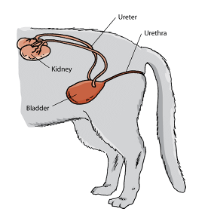The Silent Danger: How to Detect and Prevent Urinary Blockages in Cats
Is your beloved feline companion showing discomfort while using the litter box? It’s time to delve into feline health and explore the crucial topic of urinary blockages in cats. At College Hills Veterinary Hospital we understand that your cat’s well-being is paramount. In this article, we will explore the signs and causes of urinary blockages in cats and the preventive measures you can take to keep your furry companion safe.
Understanding urinary blockages in cats
 |
 |
Urinary blockages occur when an obstruction in the urinary tract prevents the normal flow of urine. Various factors, such as bladder stones, tumors, or inflammation, can cause this obstruction. Both male and female cats can develop urinary blockages; however, it is more common in males due to their narrower urethra.
When urine cannot flow out of the bladder, it can cause pressure buildup, leading to discomfort and pain. Urinary blockages can result in kidney damage, bladder rupture, and even death if left untreated.
Urethral obstructions can be caused by plugs (a mix of mucus, crystals, and inflammatory cells), stones, blood clots, masses, or congenital defects.
- Crystals and Stones: Crystals and stones can form in the urinary tract, causing blockages. These crystals are often made of minerals like struvite or calcium oxalate.
- Mucus and Blood Clots: Sometimes, mucus or blood clots can obstruct the urethra, making urination difficult for your cat.
- Inflammation: Inflammation of the urinary tract lining can narrow the urethra, leading to blockages.
- Bladder Stones: These are hard, mineralized accumulations that can form in the bladder and cause blockages.
- Birth defects: Some cats have birth defects in their urinary system. Although they are not very common, the symptoms can mimic other causes of urinary blockages. Early detection and proper management of congenital disorders may result in restoring urinary bladder and urethral function.
- Tumors: Although rare, tumors in the urinary tract can obstruct urine flow.
Signs and symptoms of urinary blockages
Detecting urinary blockages in cats can be challenging as they often do not show obvious symptoms until the condition has progressed. However, there are some signs that you can look out for, such as:
- Frequent trips to the litter box
- Small amounts of urine in the litterbox
- Straining to urinate
- Vocalizing while urinating
- Blood in the urine
- Licking the genital area excessively
If you notice any of these symptoms in your cat, it is crucial to seek veterinary care immediately. Early detection and treatment can prevent complications and improve your cat’s chances of recovery.
What to do if you suspect a urinary blockage in your cat
A cat’s urinary blockage is a serious medical emergency requiring immediate treatment. It is most commonly seen in male cats and can be life-threatening if not addressed promptly. In particular, cats with a blocked urethra may develop acute kidney failure and very high blood potassium concentrations. Life-threatening consequences can occur in as little as 12-24 hours of being unable to urinate. Death from untreated obstruction may occur in as little as 36-48 hours.
If you suspect that your cat may have a urinary blockage, it is crucial to seek veterinary care immediately. Your veterinarian will perform a physical exam and may recommend additional tests, such as blood work, urinalysis, X-rays or ultrasound, to diagnose the condition accurately.
In some cases, your veterinarian may need to insert a small tube into the urethra to remove the obstruction. In severe cases, surgery may be necessary to remove the blockage.
Preventing urinary blockages in cats
Stress is one of the key triggers for urinary blockages in cats. Below are some best practices that you can implement to maintain your cat’s urinary health. These include:
- Providing a balanced diet that is low in magnesium, phosphorus, and ash. College Hills Veterinary Hospital offers nutritional counseling and can guide you to proper nutrition for maintaining urinary health.
- Encourage your cat to drink plenty of water by providing fresh water sources and using a water fountain.
- Reducing stress by providing a comfortable and safe space for your cat to retreat to. Consider using pheromone diffusers or collars such as made by Feliway.
- Keep the litter box clean and easily accessible. Monitor your cat’s litter box habits and urine output.
- Regular veterinary check-ups to catch any urinary issues early.
Conclusion: The importance of early detection and prevention
Urinary blockages in cats are a grave and potentially life-threatening condition when left untreated. Don’t wait for the silent danger to escalate. At College Hills Veterinary Hospital, we urge you to reach out to us at the first signs of a possible obstruction. Early detection and swift veterinary care are paramount in preventing complications and improving your cat’s chances of recovery.
Understanding the signs, risk factors, and preventive measures for urinary blockage can help safeguard your cat’s urinary health. Remember to provide a balanced diet, encourage hydration, and seek to maintain a stress-free environment. You can help ensure that your furry friend lives a happy and healthy life with proper care.
Your Caring Team,
